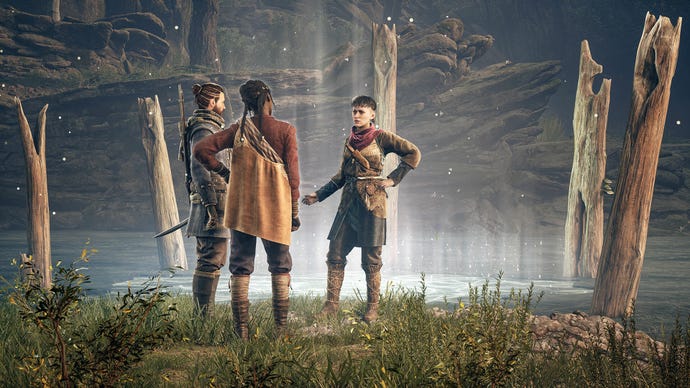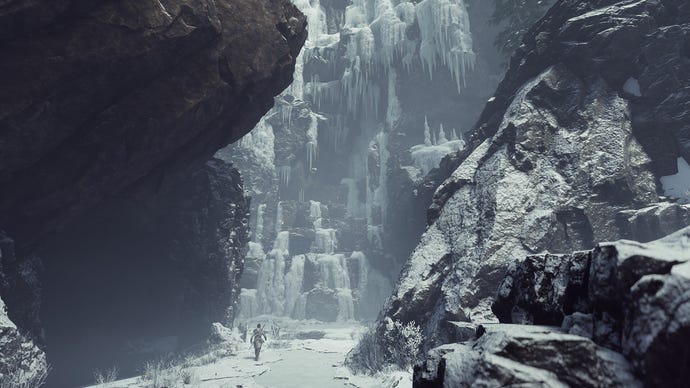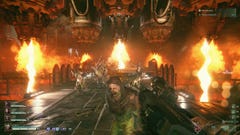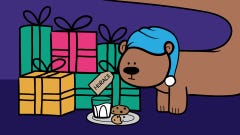Banishers: Ghosts Of New Eden wants to be a thoughtful blockbuster on a budget
A chat with Don't Nod about moral choices, world design and life after Vampyr
Banishers: Ghosts Of New Eden is a game of twos. It has two protagonists and two broad ways of playing, leading to two broad narrative outcomes, and is created by a company who, as Don’t Nod’s lead narrative designer Elise Galmard explained to me at a preview event, feel like they make games for two different audiences - fans of noodly narrative intrigues on the one hand, and of fantasy combat games on the other. Among the game's challenges, of course, is to blend these halves convincingly.
A spiritual (hah) follow-up of sorts to 2018’s fairly well-received Vampyr, it takes place in the alt-historical realm of New Eden, which is kind of 17th century colonial North America through the lens of Dragon Age: Inquisition with a pinch of Hellblade: Senua's Sacrifice. The titular Banishers are a ghost-hunting couple, the Scotsman Red MacRaith and the Cuban Antea Duarte. Antea is killed at the very beginning of the game, during a battle with an especially noxious spook, but she soon returns as a spirit, and your overall story objective is to either resurrect her body or help her "Ascend" to the afterlife.
To achieve either outcome, you must investigate various hauntings throughout New Eden, flushing out miscreants both supernatural and tangible. Having got to the bottom of each mystery, you can "Blame" the spook in question to harvest their vitality - the ultimate punishment for any crimes they may have committed. Or you can grant them a more forgiving "Banishment" or even an Ascension of their own, showing kindness while earning fewer ghost points towards Antea’s second coming.
The process of investigating a ghost blends straightforward CSI sleuthing and dialogue interrogations with a touch of spellcraft. During my hands-on, I looked into the fate of one Jacob, a trapper who had somewhat lost his wits over the mysterious absence of his companion Ben. Suffice to say that Ben hadn’t just got lost picking daisies in the woods. In the course of 30 minutes or so, I roamed a small search area spread across different elevations, scrawling sigils in the earth to play back phantom memories, and dispelled a spectral mist that hid some critical evidence. I enjoyed this side of the game, though I didn’t find it a struggle to locate all the clues and put the pieces together: it felt more like playing out the solution than discovering it.
I was less sold on the other half of Banishers - the travelling and combat sequences that intersperse the ghost-hunting. The game’s brawls encompass melee combos, dodges, blocks, gunfire and magic, and see you switching between flesh-and-blood Red and wraithlike Antea to whittle foes down and exorcise them. There’s a lot going on: each character gets their own unlock tree, damage types, and slowly recharging special moves, while enemies range from irritating zombie dogs to bosses such as undead fishermen who can perform area attacks and have more pronounced weakpoints.
While a step up from Vampyr in terms of animations and effects, it feels once again like a bit of a muddle: customisation at the expense of elegance and focus. But I can see myself enjoying the intricacies with a bit of practice, and at an estimated 20-30 hours in length across four or five regions, Banishers gives you room to stretch your legs. The setting is also more intriguing than I expected, though Don’t Nod’s recent Jusant is by far the more compelling creation. It's a world of lowering black rock, moody forests and downtrodden villages that appears to have something to say about real-world colonialism, though Don't Nod were predictably tight-lipped when I pushed for details.
I might have more to say in the weeks to come. In the meantime, here’s a chat with the aforesaid Elise Galmard and Don’t Nod’s head of creative Phillipe Moreau to discuss how Banishers approaches the ever-thorny question of game-length moral choices, how you make a gameworld feel vast on a relatively modest budget, and how Vampyr’s apparently considerable success has shaped the company’s direction.


RPS: Can you change your mind about whether to resurrect or ascend Antea as the game goes on? Early on Red and Antea form a pact about whether they’re going to sacrifice people for her resurrection or not – can you break it later?
Elise Galmard (EG): Yeah, that's definitely the idea. We make you swear an oath at the beginning of the game. And then obviously, throughout your journey, you will be confronted by several haunting cases, several different stories, a lot of different people, and as you grow, you may change your mind because you decide that you don't want to kill people anymore. Or on the other side, you decide that actually, these people deserve to die. However you approach the game, Red and Antea will always check in with each other, see how they both feel and reflect upon the oath that you've made, versus how you're playing. And very organically, you will be able to either follow the oath that you made or at some point during the game, change your pact.
Phillipe Moreau (PM): There are no wrong or right choices, but just, let's say, options as to how you how you feel about the death, the question of the death. So it will lead to different endings, depending on the different choices that you have, that you've made.
RPS: How does this game stand apart from how other games have handled these kinds of choices in the past?
PM: I think it's part of our DNA to put a lot of effort into creating very believable stories with strong characters, complex characters, which lead to morally ambiguous choices. This is something we've already tested in Vampyr, that it worked from the player’s perspective. I think we're just doing what we do best. It’s our goal to always challenge the players to question themselves, by creating very different stories. And this was a good setting for creating varied stories, with people who have very different backgrounds, coming from Europe to this new world, with their own secrets that we will have to discover. It’s a very rich source of ghost stories for the narrative team.
EG: I think the theme of the ghost is very interesting in terms of moral choices, because they're such a mirror to our own humanity. Having people coming from Europe with their own baggage and secrets into a setting that is filled with history and bigotry. It helped us create this very multi-dimensional setting, and a set of people that are very complicated. And obviously, the more you know someone, the more you bond, the more information you have about their emotional life, how they're feeling, what they're thinking - which is what we do through the haunting cases - the more difficult it is to pass judgement upon them. And that was the whole idea, that at the end you bring closure to a haunting case - you're not here to judge them. And that's what makes it even more difficult - that you understand them. And at the same time, what we saw throughout playtesting is that people have really different reactions or thoughts. The haunting case that you just completed, with Jacob, people really hate him or really love him and don't want to kill him. And so that's, I think, definitely a victory.
PM: What did you do with Jacob?
RPS: I Blamed him, but that’s only because I know that when I play the finished game I’ll wuss out and spare everybody. Preview events give me a chance to be nasty!
EG: Well, sometimes you will really want to Blame people!

RPS: This seems very heavily inspired by Vampyr. Can you tell me what you’ve brought back from that game and what you wanted to do differently?
PM: Yeah, the idea when we started Banishers was to improve all aspects of Vampyr – the gameplay, visuals, the technical aspects also. So for example, the combat system - we decided to completely rework it, to create something much more rewarding, much more based on look and feel. We analysed the key features that we wanted to transfer in some sort, like the fact that you have several people with pasts and secrets that you need to investigate, in order to make choices. This is the key feature that we have kept in Banishers.
EG: It's the investigations as well, when you're investigating lives, we took the hint and insight system from Vampyr, and we kind of built it up to have a more hands-on feel with more tools for the Banisher to investigate Hauntings. So as you saw, you can talk to people you can search around, you can see memories and rituals. We've tried to really diversify the way we do investigations.
RPS: I was interested by one of the lines from the demo when Antea says something like, “this colonised land is haunted”. Do you explore the idea of a colonised land being haunted at length in the game?
EG: It's not an overarching theme. We definitely acknowledge the fact that we're on colonised land, especially coming from Antea’s perspective, who comes from Cuba, which was also colonised. And so this is something that she has lived herself. And so it's mentioned, it's acknowledged, it’s respected. It's not the theme of our game, but it's definitely something that is acknowledged for sure.
RPS: Have you sought advice from, for example, Cuban people or Cuban organisations about how that colonial heritage is played out in the game?
EG: Yeah, we have a lot of sensitivity readers. In terms of people who were directly involved, for sure.
RPS: This is more of an open-ended question, but I'm interested in how you make a video game world feel big without having to literally make it big. I was recently reading about Link's Awakening on the Game Boy, and how the overworld map is kind a labyrinth – you have to keep doubling back in weird ways, and that makes it feel larger. And I'm interested to know if you've done anything like that with this game, because I enjoy how grand the world feels while also being very claustophobic, if that makes sense?

PM: That’s quite a difficult question. How did we do that? Choosing this particular setting allows us to create what we want - that was the first step compared to Vampyr, which was set in London, though we took liberties. In this setting, it was easier to create our own world with its own rules and limits. So in terms of spaces, we were very free. And then we just took inspiration from different media and movies, like, for example, The Revenant or The Village, which [blend] this kind of setting with great photography. I think the lighting also plays a big role in the atmosphere. And then it's how we define the different regions, the different biomes, and try to constantly change the atmosphere and the vegetation, etcetera, so the player never gets bored. It's all about landmark points of interest, leading the players where we want them to go.
EG: It's also a team effort between different fields – you were saying that it feels claustrophobic, or it feels like it's really big, like I'm gonna get lost. And I feel like that really encompasses the fact that there was a lot of us building the world together, be it the level designers, the environmental artists, the narrative designers, we were all working together to really create the mood. I think the fact that we all worked together throughout the whole process of the production, just a lot of iterations and fixing and then oh, maybe this needs 'more tunnel', maybe this needs to be more open, because at this point in the story [we want the game to feel like this] - the more we played, the more we redesigned, redesigned, redesigned.
PM: We are just a double-A budget game, compared to big, triple-A games that have the pressure to make these kinds of big worlds, filled with so many activities to do. That's not really how we envision our world. We first think of the setting, of the people living there, and just try to make something consistent and believable, but we never compared ourselves to the big open worlders.

RPS: I like that - I'm very burned out on open worlds where there’s so much to do. It feels like you want Banishers to feel a bit like an Ubisoft game, with the huge map and the campfire hubs, but you also don't want it to feel overwhelming, and obviously, you don't want it to be incredibly expensive to make. On that note, can you tell me about how Don’t Nod is set up right now? How many people do you have on the books? How many people are working on this, versus other projects?
PM: It’s quite confidential, but in terms of the company, we are around 300 people working on different projects. So we can say that Don’t Nod is growing, year after year, in terms of team sizes but also in terms of diversity of projects. That’s all I can say.
RPS: I’m not fishing, I promise! What has been the major source of your growth, over the past few years?
PM: The biggest success is Vampyr, definitely. And after, we've just been looking for different partners to help us create new IPs, with Focus who published Vampyr and are now [collaborating with us] on Banishers. It’s about creating a close relationship - they believe in our potential and so they helped us to finance the project, which is a very big venture, the company’s biggest project. So yeah, that's how it works - trying to find partnerships with different publishers.
RPS: It’s interesting that Vampyr is your biggest success, given that critics are more fond of your other games. Reviewers liked Vampyr, but I'm not sure many of us saw it as iconic in the same way as Life Is Strange.
PM: Yeah, Life Is Strange is the game that kickstarted Don’t Nod’s [fame], but it’s not the game that made the most money. I hope that Banishers will also be a hit.
EG: We definitely have two sorts of fanbases at Don’t Nod. We have fans of Life Is Strange, Tell Me Why, and recently Jusant that just came out - smaller projects, more narrative-driven - and then we have things like Remember Me, Vampyr and now Banishers. And yeah, that's great!










